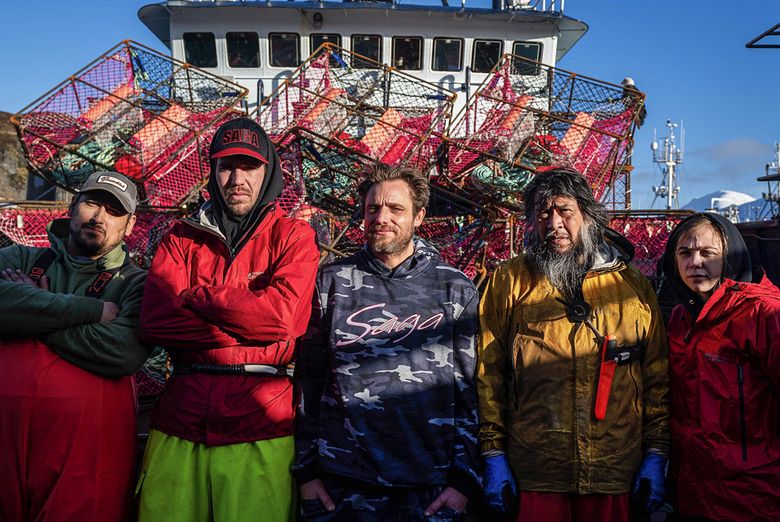UNALASKA, Alaska — Around this Aleutian island and the nearby port of Dutch Harbor, the “Deadliest Catch” boats are easy to spot.
They have cameras mounted above the decks. They may have well-dressed producers standing on the dock and, on occasion, are pursued by helicopters buzzing low overhead as they jog about island bays.
This year, nine Bering Sea crab boats will appear on the Discovery Channel show’s 18th season, premiering April 19. That represents nearly a quarter of the 39 vessels registered as of March 21 to catch snow crab in the 2022 harvest, which has been greatly reduced due to conservation concerns.
Some are smaller boats that may have a more difficult time operating in the cold, rough water of the northern Bering Sea, where surveys indicate most of the crab were to be found this year. But with the money paid by Discovery, their captains had plenty of added incentive to keep crabbing — and keep their crews employed — in 2022 rather than transferring small catch quotas to larger boats.
Just how much “Deadliest Catch” pumps into the crab fleet is largely kept confidential.
Soon after the show first got started in 2005, David Lethin, owner of the Aleutian Ballad, said he got paid $10,000 for putting his vessel and crew on the show during the king crab season and an additional $10,000 for the snow crab harvest.
Through the years, the TV series has gained popularity around the globe, and skippers repeatedly featured on the series have become celebrities.
“I can’t tell you much or I would get in trouble. But it’s good,” said Jake Anderson, who has appeared on “Deadliest Catch” for 16 years and now captains the 107-foot Saga, an older boat built in 1979.
The show is steeped in images of crabbers facing turbulent seas.
The Aleutian Ballad was involved in a celebrated episode that aired in season two of the show. A rogue wave caught on camera knocked the vessel on its side, and flooding caused the engines to cut off. Somehow, the boat righted itself, and the crew was able to make it safely back to port.
In one notorious incident caught by TV cameras, a crew member on the Wizard shed most of his clothes and jumped overboard in an unsuccessful attempt to help bring aboard a putrid, dead walrus, valued for its tusks.
But there also is room for make-believe, as captured in a January photo posted to Facebook that circulated among the fleet.
The photo shows a hose-wielding member of a production crew spraying a deluge of water over the head of Sig Hansen, skipper of the Northwestern, as he stepped out the door of the Dutch Harbor airport. That made it appear Hansen was arriving in foul weather even as blue skies were overhead.
Producers of “Deadliest Catch” said in a written statement that for promotional and marketing shots, on “very rare occasions,” hoses are used to “mirror the real-life conditions” facing the crab fleet.
The Sig Hansen airport photo made the rounds of bemused crab boat captains as they prepared to start this winter’s snow crab season.
“I’m never going to do that,” said Mark Casto, captain of the Seattle-based Pinnacle.
Casto acknowledges that “Deadliest Catch” has been a marketing bonanza for Alaska crab, but the fake rain is one more reminder why he is fine with his boat staying off the show.
Casto’s wife, Kristen Casto, also is relieved the Pinnacle is not featured on the Deadliest Catch. She married Casto when she was just out of high school and has put up with the decades of seasonal separation from their home in Mukilteo.
She feared some accident could unfold aboard the boat, then end up replayed over and over on television.
“I don’t need my kids to see that. We don’t need that in our lives,” she said.
Some crabbers say that some “Deadliest Catch” skippers take extra risks to infuse more drama into the show.
Pinnacle crew member Jack Bunnell formerly worked on Anderson’s Saga. He said that on occasion, to make for better footage, the captain pounded the boat into the seas. He then made the crew set pots facing into the wind so they got exposed to waves coming on board, rather than turning the vessel to offer more protection on the leeward side.
“You got to make it exciting, somehow,” Bunnell said. “What we do, hauling pots 24 hours a day, is boring.”
Bunnell had a mishap on the Saga when a steel-framed pot broke free from a launcher, slamming painfully into his leg.
The accident occurred while Anderson was pushing the crew to haul at a fast pace and was aired in 2019. Shortly before that footage, a crewman is shown on camera stating that “safety is not a factor right now.”
Bunnell walked off that injury. He was subsequently fired from the Saga when he defied Anderson and went out for a shore-side drink, an incident also aired on the show.
“It (‘Deadliest Catch’) was a lot of fun; I’m not going to lie. But, for me, it wasn’t a lot of money, and the Pinnacle is a way better boat,” said Bunnell.
Anderson says he will not put the crew at increased risk to try to make for a better scene.
“I’ve never … done anything deliberately unsafe for effect on television,” Anderson said.
The Saga crew gets pushed harder once the cameras, and the scrutiny they bring, are off the boat, Anderson said.
Deadliest Catch producers said, “We do not compromise safety for TV purposes. Our camera teams are invited guests on captains’ boats, and they run and operate their boats independent of the TV crews.”


